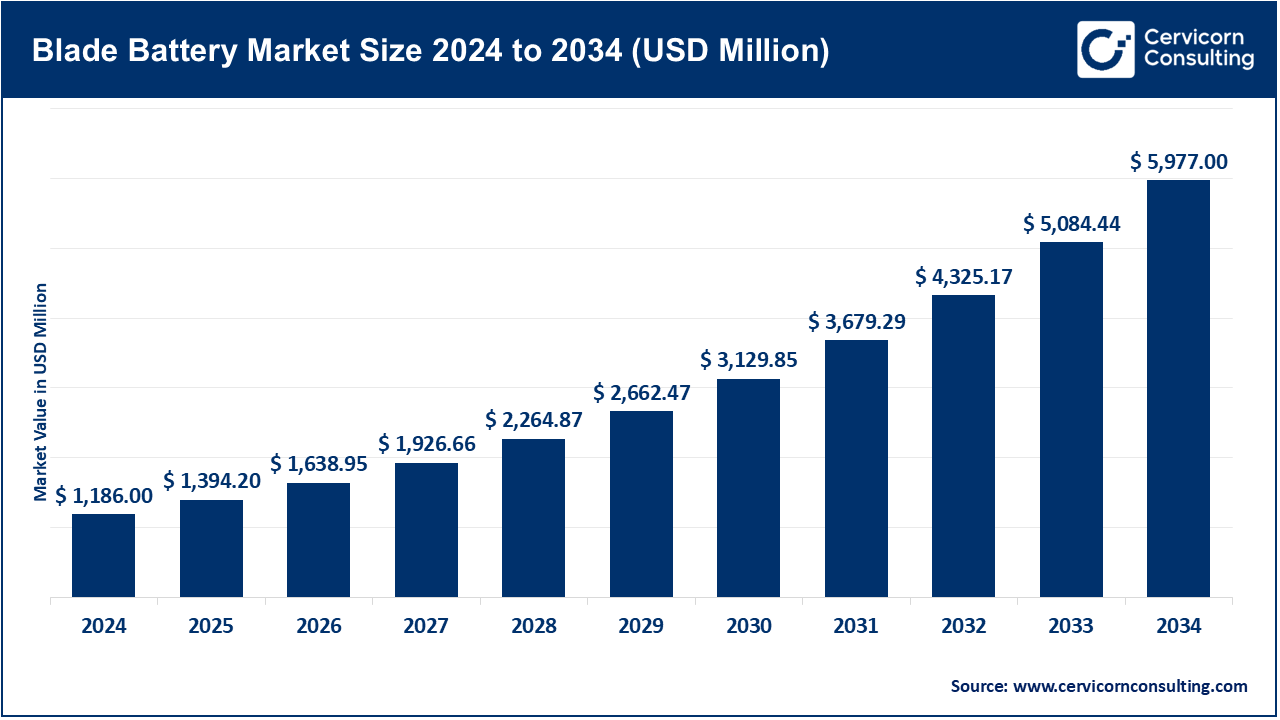Blade Battery Market Size
The global blade battery market was valued at USD 1,186 million in 2024 and is projected to reach USD 5,977 million by 2034, growing at a CAGR of 19.69% from 2025 to 2034.
What is the Blade Battery Market?
The Blade Battery Market pertains to the sector involved in the development, manufacturing, and deployment of blade batteries. Blade batteries are a type of lithium iron phosphate (LFP) battery characterized by their elongated, blade-like structure. This design enhances space utilization and thermal management, making them particularly suitable for electric vehicles (EVs) and energy storage systems (ESS).
Scope and Significance
The market encompasses various segments, including:
-
Capacity Types: Small, medium, and large capacity batteries.
-
Applications: Passenger cars, commercial vehicles, energy storage systems, and more.
-
Chemistry Variants: LFP, lithium nickel manganese cobalt (NMC), solid-state, and others.
-
End-Users: Automotive, renewable energy/power storage, consumer electronics, and industrial applications.
The significance of the blade battery market lies in its potential to revolutionize energy storage solutions, offering safer, more efficient, and cost-effective alternatives to traditional battery technologies.
Get a Free Sample: https://www.cervicornconsulting.com/sample/2710
Market Trends
1. Adoption of LFP Blade Batteries in Electric Vehicles
The shift towards LFP blade batteries in EVs is gaining momentum due to their enhanced safety features and cost-effectiveness. Companies like BYD have pioneered this technology, integrating blade batteries into their EV models to improve performance and safety.
2. Integration into Energy Storage Systems
Blade batteries are increasingly being utilized in ESS, driven by their long cycle life and fire resistance. This integration supports the stability and scalability of renewable energy sources, facilitating their widespread adoption.
3. Advancements in Fast-Charging Technologies
Innovations in fast-charging technologies are enhancing the appeal of blade batteries. Some blade batteries can now reach 80% charge in less than 30 minutes, reducing downtime and improving the user experience.
4. Government Incentives and Regulatory Support
Policies promoting clean energy and electric mobility are accelerating the adoption of blade batteries. Initiatives like China’s “double carbon” goals and the U.S. Inflation Reduction Act are driving demand for EVs and ESS, thereby boosting the blade battery market.
Market Dynamics
Drivers
-
Rising Demand for Electric Vehicles: The global shift towards electric mobility is increasing the demand for advanced battery technologies.
-
Technological Advancements: Innovations in battery chemistry and design are enhancing the performance and safety of blade batteries.
-
Government Policies: Incentives and regulations promoting clean energy are fostering the growth of the blade battery market.
Restraints
-
High Initial Investment: The development and deployment of blade battery technologies require significant investment.
-
Supply Chain Challenges: The availability of raw materials and manufacturing capabilities can impact market growth.
Opportunities
-
Emerging Markets: Growing adoption of EVs and renewable energy in emerging economies presents new opportunities for blade battery deployment.
-
Technological Innovations: Ongoing research and development can lead to more efficient and cost-effective blade battery solutions.
Challenges
-
Competition from Alternative Technologies: The emergence of alternative battery technologies may pose challenges to the growth of the blade battery market.
-
Regulatory Hurdles: Navigating varying regulations across different regions can complicate market expansion.
Regional Analysis
Asia-Pacific
The Asia-Pacific region holds a significant share of the blade battery market, driven by China’s leadership in EV production and adoption. Government subsidies and a strong manufacturing base further bolster the region’s position.
Europe
Europe is witnessing a surge in EV adoption, supported by stringent environmental regulations and consumer demand for sustainable transportation solutions. This trend is fueling the demand for blade batteries.
North America
In North America, the push towards renewable energy and electric mobility is accelerating the adoption of blade batteries. Policies like the U.S. Inflation Reduction Act are providing incentives for EV and ESS deployment.
Rest of the World
Other regions, including Latin America and the Middle East, are gradually adopting blade battery technologies, driven by increasing awareness of environmental issues and the benefits of clean energy solutions.
Recent Developments
-
BYD’s Blade Battery Integration: BYD has integrated its blade battery technology into its EV models, enhancing safety and performance.
-
Advancements in Fast-Charging Technologies: Developments in fast-charging technologies are reducing charging times for blade batteries, improving user convenience.
-
Government Initiatives: Policies promoting clean energy and electric mobility are accelerating the adoption of blade batteries in various regions.
For more detailed insights and data, you can visit the original source: Cervicorn Consulting – Home Healthcare Market
Read: Hydrogen Generation Market Drivers, Applications, and Forecast by 2034
